So zwischendurch - ZbV300 wird's lieben, denke ich...

Die Idee dazu hatte ich schon länger auf der Liste, aber ein GB unter dem Titel "Following in the footsteps of the P.R.19" auf whatifmodelers.com hat mich dann angeschoben, die Idee in Hardware umzusetzen: die North American Mustang FR.6.
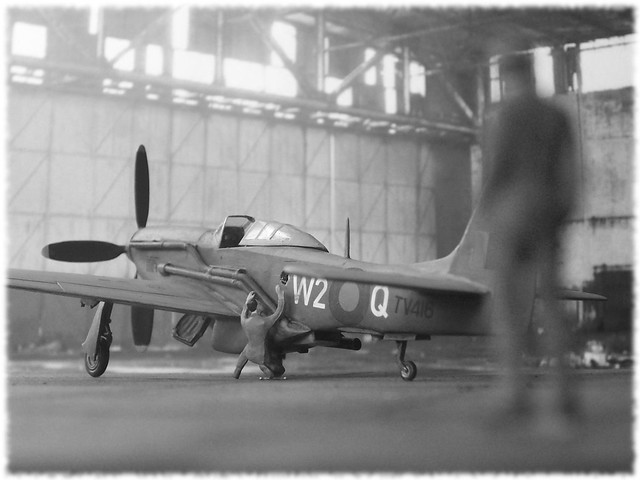
 Some backgroundThe North American Aviation P-51 Mustang was an American long-range, single-seat fighter and fighter-bomber used during World War II, the Korean War and other conflicts. The Mustang was conceived, designed and built by North American Aviation (NAA) in response to a specification issued directly to NAA by the British Purchasing Commission. The prototype NA-73X airframe was rolled out on 9 September 1940, 102 days after the contract was signed and, with an engine installed, first flew on 26 October.
Some backgroundThe North American Aviation P-51 Mustang was an American long-range, single-seat fighter and fighter-bomber used during World War II, the Korean War and other conflicts. The Mustang was conceived, designed and built by North American Aviation (NAA) in response to a specification issued directly to NAA by the British Purchasing Commission. The prototype NA-73X airframe was rolled out on 9 September 1940, 102 days after the contract was signed and, with an engine installed, first flew on 26 October.


The Mustang was originally designed to use the Allison V-1710 engine, which had limited high-altitude performance. It was first flown operationally by the Royal Air Force (RAF) as a tactical-reconnaissance aircraft and fighter-bomber (Mustang Mk I). The addition of the Rolls-Royce Merlin to the P-51B/C (Mustang Mk III) model transformed the Mustang's performance at altitudes above 15,000 ft, giving it a much better performance that matched or bettered almost all of the Luftwaffe's fighters at altitude. The definitive version, the P-51D (Mustang Mk IV), was powered by the Packard V-1650-7, a license-built version of the Rolls-Royce Merlin 60 series two-stage two-speed supercharged engine, and armed with six .50 caliber (12.7 mm) M2 Browning machine guns.
The Mustang VI (later re-designated FR.6; the Mustang V was a lightweight fighter of which only one prototype reached England) was an indigenous, British project that was based on the P-51D. It was to meet Air Ministry Specification F.4 of 1940 for a high altitude fighter, designed to fight at extremely high altitudes, in the stratosphere.
Background was that Great Britain feared, with an ever increasing air superiority over the British Isles, that German bomber raids might come in at very high altitudes in the near future, staying out of reach from conventional defense measures. Earlier reconnaissance flights of Ju 86P aircraft had already shown that this was a realistic scenario. Additionally, the domestic development progress of pressurized cockpits for high altitude fighters convinced authorities that Germany would easily be on the same technical level, so that a high altitude interceptor was indeed needed.
While Westland and Vickers responded with twin-engined designs, North American was also requested to modify the relatively new Mustang (which was designed for medium to high altitudes) for extreme altitudes, as F.4/40 specification was revised into F.7/41 in early 1941. British pressurized cabin technology was to be incorporated, but the engine could be based on US technology.
North American was quick to respond and modified a P-51D airframe. This prototype was internally coded NA-73HK and ready for inspection in mid-late 1942.
The NA-73HK’s most obvious feature was the enormous high aspect ratio wing, achieved by extended wing tips, together with a fortified internal wing structure and weight saving measures (which had already been designed for the lightweight Mustang V). This new wing necessitated enlarged tail surfaces and a slightly elongated fuselage to provide a longer moment arm.
The aircraft was powered by a Packard V-1650-20 engine that delivered 1.233 hp (920 kW) at 35,000 ft (10,668 m). It was based on the Rolls Royce Merlin 76 (RM 16SM), but instead of the standard two-speed, two-stage supercharger it was coupled with a General Electric C-23 turbo-supercharger. The system was fitted with A.D.I and a General Electric ignition system with a tubular ignition harness developed by the Scinitilla company. A water injection system was added for short-term power boosting, too. The original Bendix-Stromberg carburetor was retained, even though optimized for lower air density use and a higher air mass flow. It drove a new, four-bladed propeller with increased diameter and enlarged single blade area.


Since the slender P-51 airframe did not allow the placement of the turbo-supercharger in front of the cockpit it was re-located into a large ventral fairing which replaced the original radiator tunnel – the basic layout resembled that of the P-47 Thunderbolt. But due to lack of internal space the system had to be connected through external exhaust pipes running along the fuselage flanks. This was a draggy arrangement, but it would not matter much anymore once the aircraft was at its intended operating altitude of 40.000 ft (~12.000m) and beyond.
The cockpit retained an aft-sliding bubble canopy, even though it had to be reinforced and was quickly recognizable through its stiffener bars. The cockpit pressurization system was driven by a separate Rotol supercharger attached to the engine, providing a constant pressure of 3.5 psi (24 kPa) over the exterior pressure. This resulted in an apparent cabin altitude of 24,000 feet (7,300 m) when the aircraft was operating at its design altitude of 45,000 ft (14,000 m).
This cabin altitude was still too high for normal breathing, so the pilot had to wear an oxygen mask during flight. A rubber gasket filled with the pressurized air sealed the canopy when the system was turned on, and a valve ensured the pressure was controlled automatically. Moreover, the pilot also had to wear a high altitude suit as he might have been required to bail out at altitude.
Detail work turned into time-consuming process, though. For instance, the Mustang VI, how the type was called by the RAF, and “The White Horse” by its pilots and service drews, required a new, sophisticated electrical system. This was necessary in order to minimize the number of seals and points of entry into the cockpit for the controls and instrumentation. It worked, but it was complicated: it took an electrician experienced in the features of the Mustang VI almost four hours to undertake a pre-flight check of this system!
The armament was modified, too. The original six 0.5" machine guns were to be replaced by four long-barreled Hispano 20 mm cannon in the wings. These offered greater range and ensured more damage against the expected, big targets.

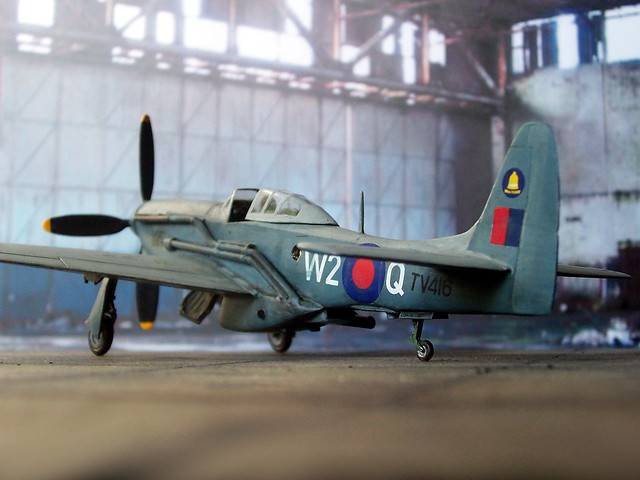
Five prototypes were used in the development process in early 1943. Despite its complexity the White Horse proved to be successful, as it easily reached 50.000 ft. (15.000 m) altitude and handled well. But production was delayed as the standard P-51D had priority and no immediate high altitude threat from Germany materialized.
Serial production eventually started in mid-1944, but at a much smaller scale than initially planned: the original production plan from late 1942 demanded no less than 500 specimen, but towards late 1943 this drastically reduced to 100, and eventually only a mere 50 of these aircraft actually reached its exclusive user, the Royal Air Force, until early 1945.
When the Mustang VI arrived at the frontline in January 1944, there was virtually no sign of high altitude aircraft to be intercepted – and there was hardly any other use for this specialized aircraft. As a consequence most of the almost new airframes were modified to carry cameras for high altitude reconnaissance missions. These machines were converted by the Forward Repair Unit (FRU) to have two camera compartments fitted: one behind the cockpit cabin, facing to port or starboard, with respective windows added behind the cockpit and above the turbocharger compartment, and another in the extension segment in front of the tail wheel, where up to two vertical cameras could be mounted (even though the location proved to be rather unsuitable, as hot air from the radiator and oil leaking from the turbocharger frequently obscured clear vision). These modified aircraft were re-designated Mustang PR.VI, which turned into FR.6 from late 1944 on.
After WWII hostilities ended, a small number of Mustang FR.6 was kept in RAF service and allocated to squadrons in Germany and in the Far East, where the aircraft were exclusively used for reconnaissance duties.


One of the type's last missions took place in 1951, when Hainan Island (People's Republic of China) was targeted at the behest of U.S. Naval Intelligence for RAF overflights. RAF Mustang FR.6 of 80 Squadron, based at Kai Tak Airport in Hong Kong, were deployed, together with Spitfire PR.19 from 81 Squadron.
General characteristicsCrew: 1
Length: 34 ft (10,37 m)
Wingspan: 48 ft 9½ in (14.90 m)
Height: 14 ft 7½ in (4.46 m) w. tail wheel on ground & vertical propeller blade
Empty weight: 4,870 kg (10,737 lb)
Loaded weight: 5,100 kg (11,244 lb)
Max. take-off weight: 6,020 kg (13,272 lb)
Fuel capacity: 1,200 l (264 imp gal)
Powerplant1× Packard V-1650-20 liquid-cooled piston engine, rated at 1.233 hp (920 kW) at 35,000 ft (10,668 m)
PerformanceMaximum speed: 420 km/h (261 mph; 227 kn) at sea level, 660 km/h (409 mph) at 15.000 m (49.130 ft)
Cruise speed: 362 mph (315 kn, 580 km/h)
Range: 460 km (286 mi; 248 nmi) at maximum continuous power with 595 l (131 imp gal) of fuel at sea level; 1,440 km (895 mi) with 1,200 l (264 imp gal) of fuel at 15.000 m (49.130 ft)
Service ceiling: 50.500 ft (15.420 m)
Maximum ceiling: 55,610 ft (16,950 m)
Rate of climb: 11.5 m/s (2,260 ft/min) at sea level, 3.92 m/s (13 ft/s) at 15.000 m (49.130 ft)
Armament4× 0.787 caliber (20mm) Hispano cannons with 200 RPG in the outer wings; some aircraft only carried a pair or these or were completely unarmed to save weight
2× hardpoints for up to 2.000 lb (907 kg) of external ordnance under the wings, typically only two drop tanks were carried.
Zum ModellDas Ding hat sogar einen realen Hintegrund, nämlich Specification F.4/40 der britischen regierung, die einen Höhenjäger suchte und aus dem schließlich die Westland Welkin (falls DIE jemand kennen sollte?) hervorging - ein echter Höhenjäger. Warum sollte es also nicht aus den USA eine leichtere Alternative gegeben haben?
Basis des Umbaus ist eine Hasegawa P-51D, an der aber viel verändert wurde, u.a.:
● Flügelspitzenverlängerungen mit Teilen einer HUMA Me 309 (Winkel von Vorder- und Hinterkante passen perfekt!)
● Verlängertes Heck, mit einem 1cm-Plug vor der Finne
● Verlängerte Finne, der obere Teil stammt von einer Special Hobby He 100D
● Neue Höhenruder, von einer ART Model Bv 155
● Neuer Kühlertunnel - aus Teilen der Bv 155 gescratcht
● Größerer Vergaser-Lufteinlauf, von einer Matchbox Martin Marauder
● Kamerafenster im Rumpf - hinterklebte Löcher, die mit Humbrol Clearfix und schwarzer Glasmalfarbe verfüllt wurden
● Neuere propeller; der Spinner ist OOB, die Blätter aber auch von der Bv 155
● Neue Haube mit Streben - ebenfalls von der Bv 155 und rel. einfach implantierbar!
● Lang-läufige Hispano-Kanonen, von einer Special Hobby Spitfire F.22
● Neue Räder, vom Startwagen einer Me 163B
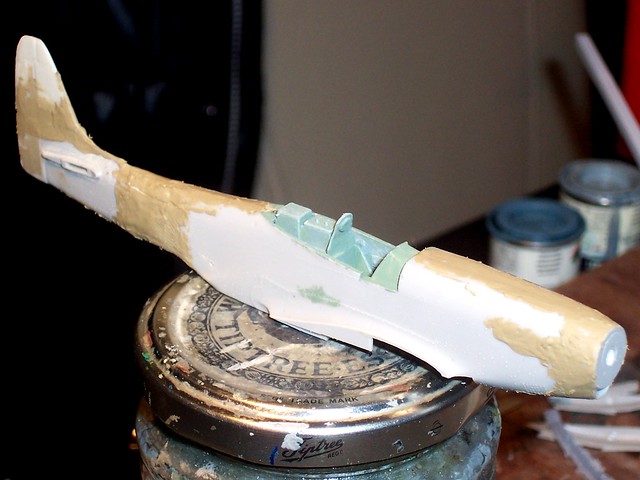
Die Abgasanlage ist nach Vorbild der Bv 155 aus Styrol-Streben gescratcht.

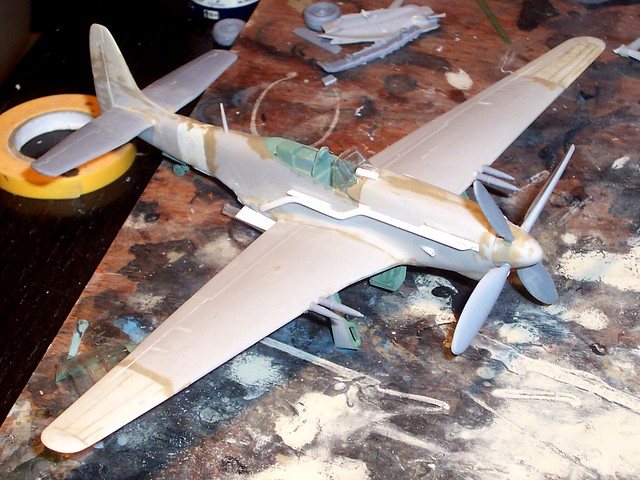
Bemalung und Markierung orinetiert sich an Nachkriegs-Fotoauflärern der RAF, wie die Spitfire PR.19, oder eben die Prototypen der Welkin: PRU Blau von unten, Mittel-Seegrau von oben, mit gedämpften Hoheitsabzeichen (Aufkleber sind zusammengepuzzelt, "stimmen" aber).


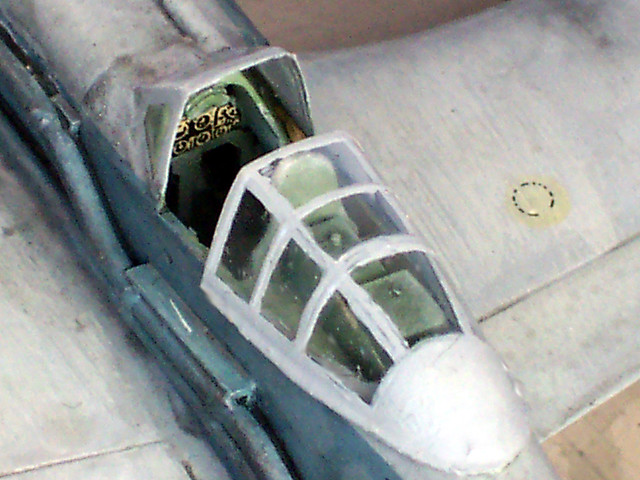




Tja, pottenhässlich oder konsequent? Die Meinungen gehen da durchaus auseinander...
